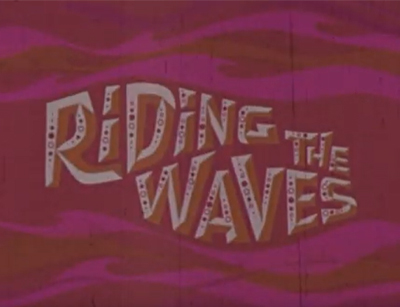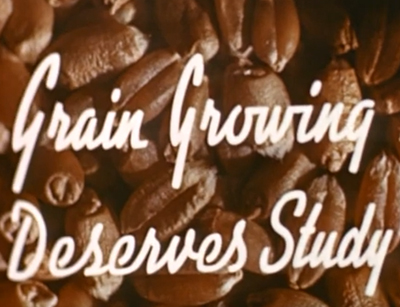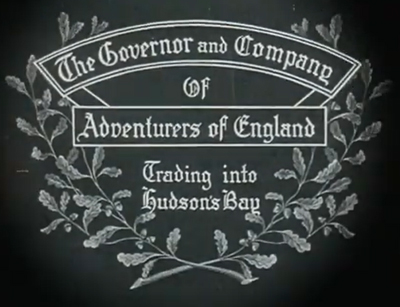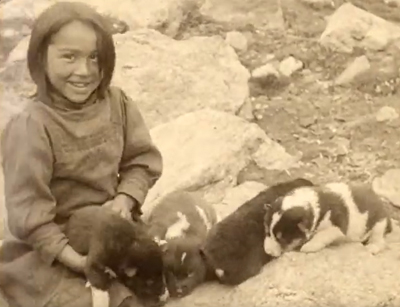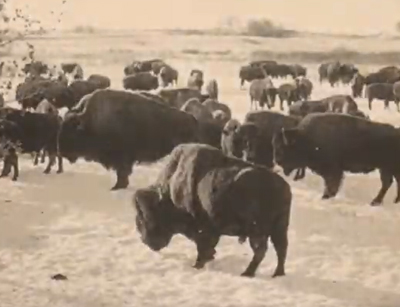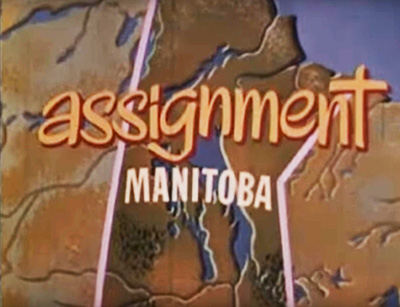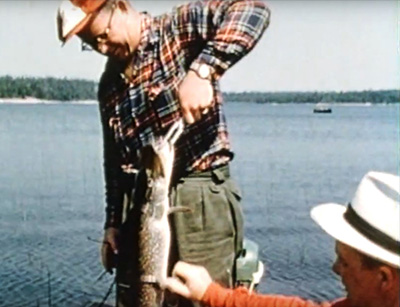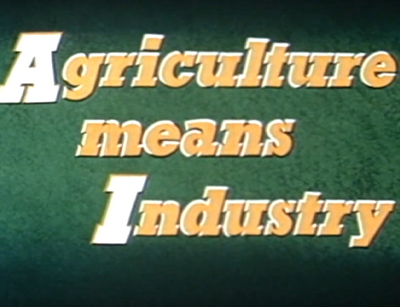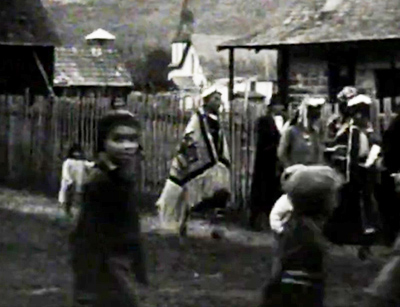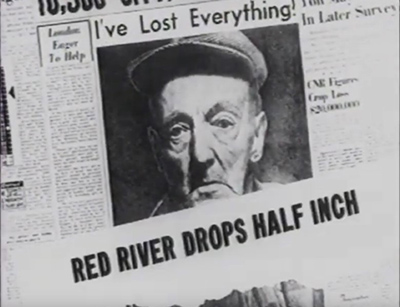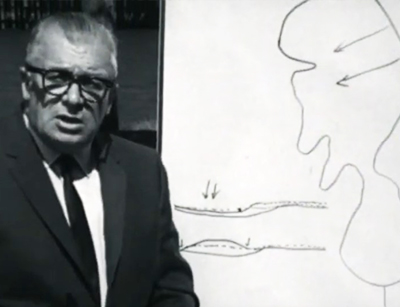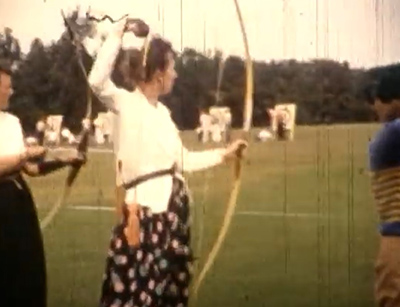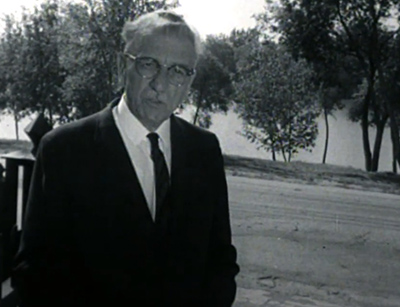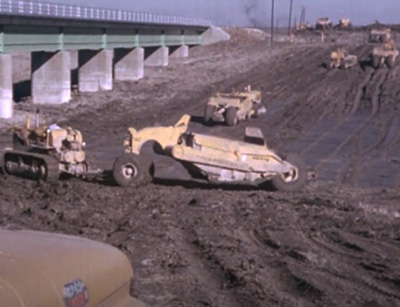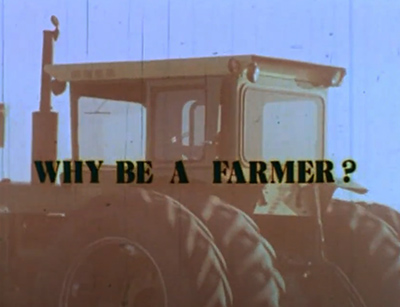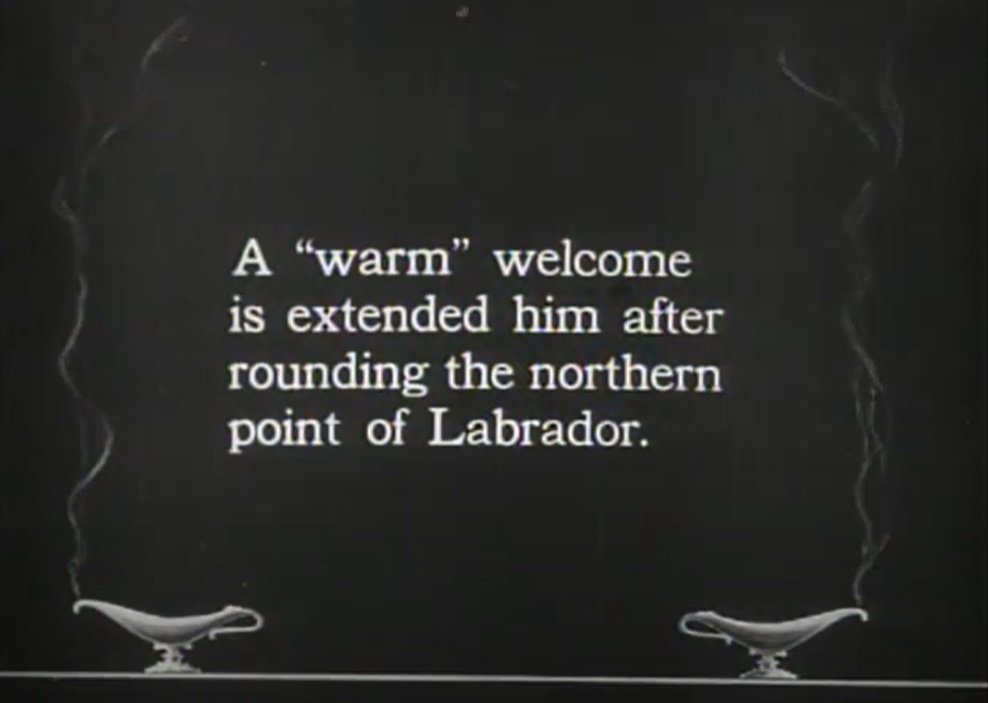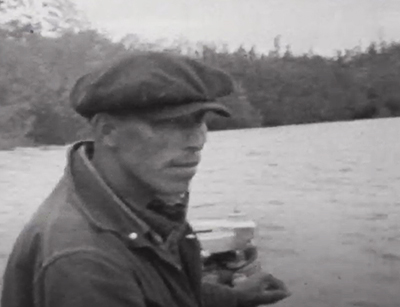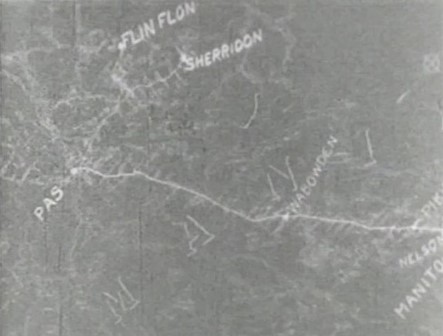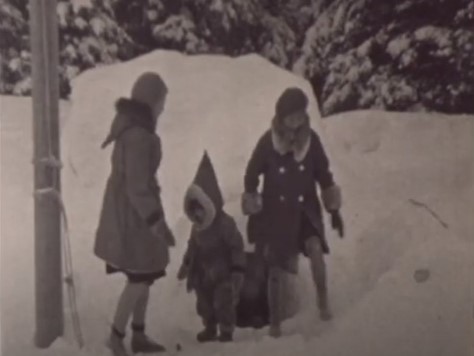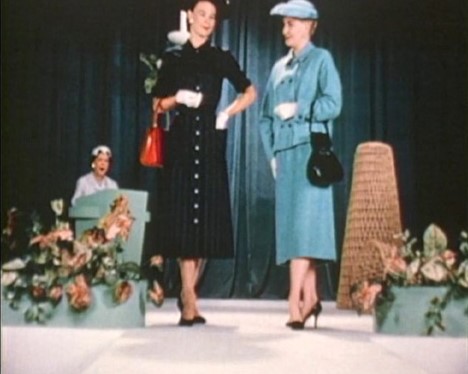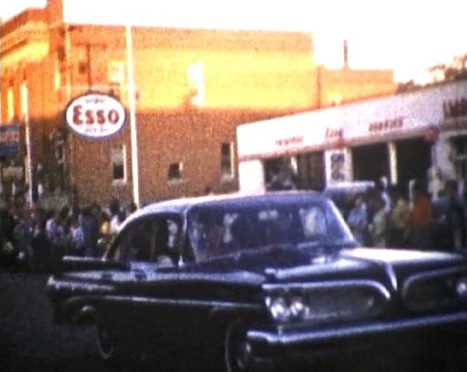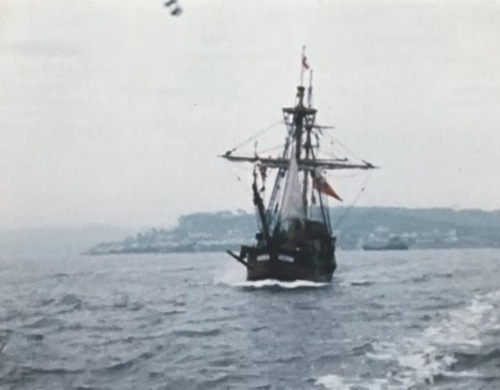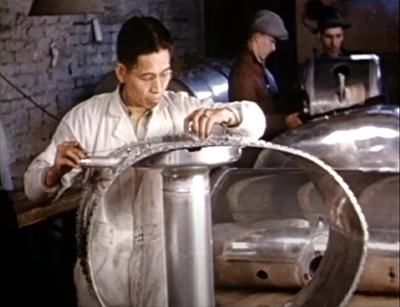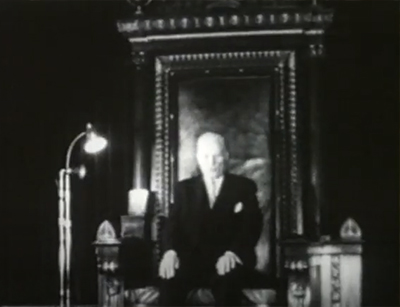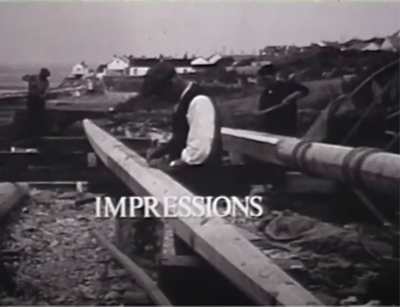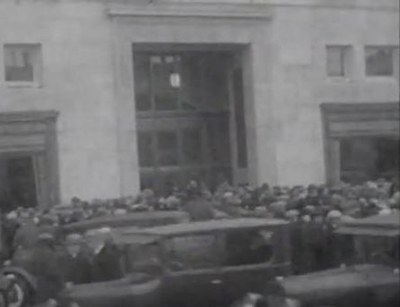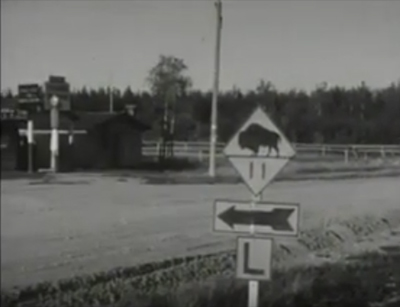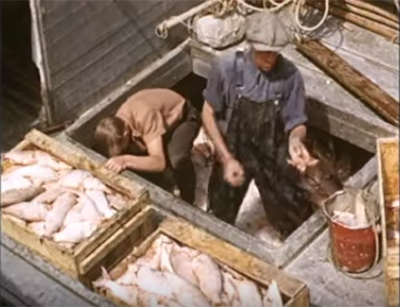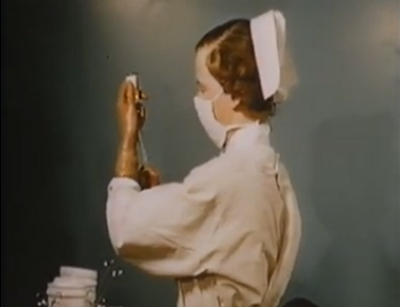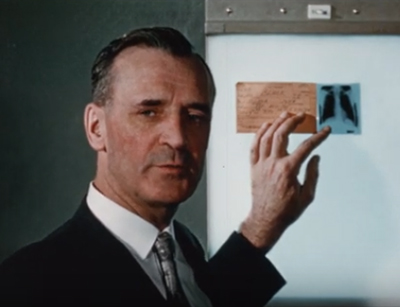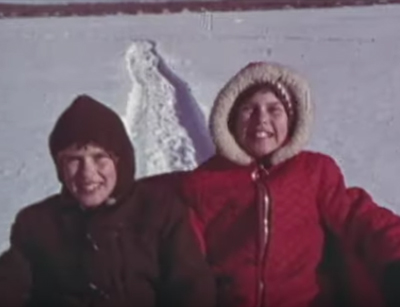Streaming from the Archives
Watch digitized films and videos from the Archives of Manitoba's holdings, including the Hudson's Bay Company Archives. These records illustrate a range of events, activities and iconic sites throughout Manitoba and beyond.
Archival records, descriptions and listings can contain outdated, offensive and/or harmful language and content that reflects the time in which they were created. Read our statement on language and content for information about work that we are doing to improve our descriptions.
This feature was launched on Manitoba Day 2020, with subsequent uploads in: July 2020, December 2020, March 2021, December 2021, and January 2024.
“Riding the Waves” (1970)
This film promotes Manitoba waterways for tourism and recreation. It includes footage of people enjoying activities in and around Manitoba�s lakes and rivers including boating, swimming, diving, waterskiing, scuba diving as well as picnicking and photography. The film features the Red and Assiniboine rivers, Netley Creek, Lake Winnipeg, Killarney Lake, Pelican Lake, Clear Lake, the Whiteshell, Falcon Lake, and Clearwater Lake. This film was produced by Western Films for the Manitoba Department of Tourism and Recreation in 1970.
“Folklorama Winnipeg” (1976)
This is a documentary about Folklorama, an annual cultural festival held in Winnipeg, Manitoba. It includes footage of the following Folklorama pavilions: Mug Pub (United Kingdom), Franco Manitobaine, Indigenous, Chinese, Lithuanian, Portuguese, Japanese, Indonesian, Lebanese, Budapest, German, Caribbean, Indian, Roma, Danish, Irish, and Ukrainian. This film was produced by Western Films for the Manitoba Department of Tourism, Recreation and Cultural Affairs in 1976.
“Grain Growing Deserves Study” (1940s)
Archives of Manitoba, Francis J. S. Holmes fonds, "Grain Growing Deserves Study,� [194-], V272
This film by the Manitoba Department of Agriculture's Extension Service was produced by Francis J. S. Holmes in the 1940s. The film outlines the importance of cereal grain production in Manitoba and discusses the factors that impact productivity. The film profiles the activities of Junior Seed Clubs in training youth to be knowledgeable grain farmers.
“Hudson's Bay Company Centenary Celebrations, reel 1 of 18” (1919)
This footage was taken in 1919 by filmmakers Harold Wyckoff and Bill Derr and was later edited together to make the Hudson Bay Company's 250th anniversary film called Romance of the Far Fur Country which was produced by Educational Films Corporation and released in 1920. Reel consists of the following footage: introductory title and text explaining the film and the history of the HBC; elevated view of the city of Montreal; loading the S.S. Nascopie in the Montreal harbour; S.S. Nascopie on the St. Lawrence River; ice flows off the coast of Labrador; Captain Mack on the deck of the S.S. Nascopie; Cape Chidley, the northernmost point of Labrador; S.S. Nascopie navigating through ice flows; HBC post Port Burwell; HBC employees and Inuit unloading supplies at Port Burwell; Inuit women chopping wood; Inuit women posing for the camera and modeling clothes; Inuit children leaving a house.
“Hudson's Bay Company Centenary Celebrations, reel 2 of 18” (1919)
This footage was taken in 1919 by filmmakers Harold Wyckoff and Bill Derr and was later edited together to make the Hudson Bay Company's 250th anniversary film called Romance of the Far Fur Country which was produced by Educational Films Corporation and released in 1920. Reel consists of the following footage: Port Burwell post manager and family; Inuk child and huskies; Captain Mack shooting a walrus in Hudson Strait; Beacon Island; S.S. Nascopie met by Inuk pilot Muneapick in kayak; HBC post Lake Harbour; elevated view of Lake Harbour; HBC district manager Ralph Parsons and Inuit discussing the First World War; candy scramble; feeding huskies; Inuit women and children at Lake Harbour; unloading live cargo from S.S. Nascopie; assigning hunting grounds to Inuit trappers.
“Hudson's Bay Company Centenary Celebrations, reel 3 of 18” (1919)
This footage was taken in 1919 by filmmakers Harold Wyckoff and Bill Derr and was later edited together to make the Hudson Bay Company's 250th anniversary film called Romance of the Far Fur Country which was produced by Educational Films Corporation and released in 1920. Reel consists of the following footage: bison between the Peace and Slave Rivers, Buffalo Park, Wainwright, Alberta; Trapper [Battice Plakoti] and Factor [Thomas O'Kelly] trapping fox near Fort Chipewyan; Trapper skinning animals, including fox, ermine, muskrat and lynx; Trapper and Factor trapping beaver at lodge; various furs displayed; Trapper and Factor on dog sled; thermometer showing temperature; camp scenes; sunset, probably at Fort Chipewyan; Trapper in store at Fort Chipewyan purchasing supplies; unidentified woman and Trapper in front of HBC store at Fort Chipewyan; Factor giving Trapper a gift; dog sled race at Fort Chipewyan; elevated view of Fort Chipewyan.
“Assignment Manitoba” (1969)
This film is a travelogue of Manitoba featuring Richard Joseph, travel editor for Esquire Magazine visiting friends in Manitoba, and seeing the sights. There are shots of the Winnipeg airport, a night out in Winnipeg, a rodeo, and relaxing by a hotel pool. There is footage of horse racing at Assiniboia Downs, road and driving scenes, boating, sailing, waterskiing, and flying in a plane. The film also includes footage of Lower Fort Garry, the Paddlewheel Queen, International Peace Gardens, the Brandon Fair, camping, fishing, Clear Lake, Riding Mountain National Park, and golf. There is also footage of the Flin Flon Trout Festival including the flour packing contest, making bannock, the Gold Rush Canoe Derby, and the prize-winning 42 pound trout.
“How To Live To Be 100 With Manitoba’s Help”(1955)
This film highlights the successful fishing ventures of several anglers vacationing in the Whiteshell Forest Reserve in eastern Manitoba. The film stresses the abundance and quality of fish in Manitoba lakes.
“Agriculture Means Industry”(1955)
This film was produced to attract industries to Manitoba to capitalize on the thriving agricultural industry. The film outlines how industries such as food, chemical, and machinery production would benefit from raw materials available in Manitoba, and a ready market for agricultural goods. It shows various Manitoba industries which are based on agriculture including vegetable and meat processing, sugar refining, farm machinery manufacturing and farm chemical production.
“Across the Skeena River by Cable Ferry”(1933)
This film was taken during Hudson's Bay Company Governor Sir Patrick Ashley Cooper's visit to Canada in 1933. Footage includes the cable ferry on the Skeena River; a reception at the Indigenous village of Gitwangak (then known as Kitwanga); the Indigenous brass band called Totem Pole Band of Kitwanga; the HBC store; Harrison Hot Springs, British Columbia; and the Governor and his wife, Kathleen, in a garden planting a tree.
“Our Rivers… Masters or Servants” (1961)
This film references the major floods that occurred in Manitoba back to 1826 and describes in detail the flood of 1950 including footage from that time. The film outlines findings and recommendations of the Royal Commission on Flood Cost Benefit and the resulting flood prevention measures undertaken including the Winnipeg Floodway, the Shellmouth Reservoir, and the Fairford and Portage diversions.
“Locking Through” (1968)
This film provides a description of the history and function of the St. Andrews Lock and Dam; engineering concerns and how it operates. It also includes still shots of photos of its construction and opening day ceremonies in 1910.
George Henry Hambley home movie footage of an Archery contest in Assiniboine Park, Riding Mountain National Park, Clear Lake and the Manitoba Legislative Building in Winnipeg (1958)
Archives of Manitoba, George Henry Hambley fonds, "This reel shows, --Archery contest…," 1958, V402
This home movie by George Henry Hambley shows footage from Winnipeg and Western Manitoba. Notations on the original film container described the film as follows: "This reel shows, -- Archery contest, Wpg, 1958, Canadian champions shooting in Assiniboine Par[k?] Pigeons, St. Vital. Buffalo, Riding Mt. Park, Clear Lake. Parliament Bldgs. Queen Victoria, Tympanum over entranc[e] north side. Doric Pillars. Golden Boy. Corinthian pillars. James Wolffe [sic]. Lord. Dufferin. Robert Burns. Pictured poems, Cotter's Sat. night. Tam O'shanter, "To A Mouse", Jon Sigurdson. George Etienne Cartier. Two statesmen on E of Parli[ament] Bldg ( ) and ( ). Golden Boy. Time 20 Minutes. Taken by Geo. H. Hambley."
“Construction Then and Now” (1968)
Archives of Manitoba, E 0710 Educational films produced by the School Broadcasts Branch, GR1817
This film features a comparison of the construction techniques used in building the first Grey Nuns convent (now the St. Boniface Museum) in 1846-1851, with the techniques used to build modern structures.
“Red River Floodway” (1969)
This film documents the construction and opening of the Red River Floodway, one of the biggest excavation projects in Canadian history.
“Why Be a Farmer?” (1977)
This film is about the changing nature of farming, and features Don Falk, a young man and musician and the factors he considered before deciding to take over his father’s farm and seed cleaning business at Lorette, Manitoba. The film includes Falk’s father talking about farming after his arrival from Russia in the 1930s and contrasts this with the nature of farming in the 1970s.
“The trials and tribulations of a cameraman” (1920)
This silent film documents the making of the Hudson's Bay Company's 250th anniversary film Romance of the Far Fur Country and it captures the conditions in which the film was made. Throughout the film is footage of Harold Wyckoff and Bill Derr filming Romance of the Far Fur Country. Also included is footage of the “S.S. Nascopie” navigating ice flows; an Inuit church service at Lake Harbour; canoes on the Abitibi River at Moose Factory; a First Nations hunter (Battiste Plakoti) trapping; equipment and supplies being transported by boat and sled; as well as several scenes documenting the challenges of filming in cold climates. The film has many of the same scenes that appeared in Romance of the Far Fur Country however, the film ends abruptly and appears to be incomplete.
Leif Sunde home movies of supplies being delivered to fur trading posts (between 1932-1938)
This silent film documents Leif Sunde and numerous unidentified individuals delivering supplies to H. C. Hyer Company's fur trading posts based at Norway House. Included are various scenes of canoes on unidentified rivers; portaging; camp scenes; and numerous unidentified posts (possibly Oxford House, Rossville, God's Lake and Island Lake).
“Churchill” (1931-1933)
Archives of Manitoba, George Coutts fonds, Churchill 1931-1933, V1
Keystone Fonds Description: George Coutts fonds
This silent film consists of footage by George Coutts, a civil engineer involved in the construction of the port and grain storage facilities at Churchill, Manitoba. The film documents the progress of construction of the port facilities at Churchill, Manitoba from 1931-1933. It also documents his journey from The Pas to Churchill on the Hudson Bay Railway in 1931, life at the port and surrounding area in all seasons, an RCMP patrol comprised of an officer and Inuit guide, two Inuit men constructing an igloo, a group of Inuit in a whaling boat, the arrival, loading and departure of various ships, Canadian Airways, RCAF and commercial aircraft and an overnight refueling stop by Charles and Anne Morrow Lindbergh who were en route to Japan in 1933.
“Norway House” (between 1932-1938)
Hudson’s Bay Company Archives, Archives of Manitoba, Leif and John Sunde fonds, Norway House [between 1932-1938], F79-1
Keystone Item Description: Norway House
This silent film consists of interior and exterior footage of family and social life around the H. C. Hyer fur trading post at Norway House during the summer and winter. Footage includes: an airplane taking off; children in the vegetable garden; children on swings; a soccer game; running races; dog sleds; funeral procession for an individual named Bradford; a winter trail across ice; a family picnic at Forestry Island; ice skating; and riding a bike on the ice. Individuals captured on the film include: Leif, Dagny, John, Marianne, Tanis and Leif jr. Sunde; Mickey Low; Mrs. Kemp (teacher at Norway House); Mrs. Anderson; and Mrs. Oliver.
“Mapping Manitoba” (1940)
Archives of Manitoba, A 0237 Films promoting tourism and industry, GR8398, "Mapping Manitoba," 1940, V29
Keystone Item Description: Mapping Manitoba
This silent film shows a survey crew at work in northern Manitoba, and includes much aerial footage of the northern regions. Francis J. S. Holmes, a Winnipeg filmmaker, accompanied the Department of Mines and Natural Resources survey party for a few weeks in 1940 to document the surveying of the twenty-third base line, five hundred miles north of the international boundary. This was the first survey in Canada that utilized an airplane to transport the survey party.
“Centre of Fashion” (1957)
Archives of Manitoba, A 0237 Films promoting tourism and industry, GR8398, "Centre of Fashion," 1957, V32
Keystone Item Description: Centre of Fashion
This film promotes the fashion industry in Manitoba and shows the process of designing and creating a garment. A significant portion of the film is a fashion show staged in The Bay store in downtown Winnipeg, displaying made-in-Manitoba designs.
George Henry Hambley home movie footage of Brandon, Minnedosa, and McConnell, Manitoba, and Joe McMurchy's farm (1959)
Archives of Manitoba, George Henry Hambley fonds, "Streets of Brandon…," 1959, V402
Keystone Item Descripton: “Streets of Brandon…,”
This home movie by George Henry Hambley shows footage of Brandon, Manitoba during Queen Elizabeth’s visit in 1959, as well as footage of McConnell, Manitoba and a visit by Hambley to the farm of Joe McMurchy. Notations on the original film container described the film as follows: "Streets of Brandon as the Queen visits the Wheat City. Horses at [?]. Minnedosa. Mare with colt. House of Old Joe McMurchy. Geo. H. Hambley comes up to the house - children coming out of school at McConnell. Elevators and McConnell store and McMurchy gets into car. Hitching team up watering - [?] Horse on farm old Joe goes out to field with two horses on binder - Girl brings out lunch. Joe finds two heads of wheat - gives them to the girl - Joe and old [?] sit by horse and tell of wheat - old [gun?] - Hambley shows how he planted eleven kernels - weeks later watering plants - two months more - grain well grown"
“The Voyage of the Nonsuch” (1968)
Hudson's Bay Company Archives, Archives of Manitoba, "Nonsuch" replica records, Voyage of the Nonsuch, 1968, F19
Keystone Item Description: Voyage of the Nonsuch
This film traces the construction, launching and sailing of the replica ship "Nonsuch" built to commemorate the Hudson's Bay Company's 300th anniversary.
“Manitoba Fights for Freedom” (1944)
Archives of Manitoba, A 0237 Films promoting tourism and industry, GR8398, Manitoba Fights for Freedom, 1944, V34
Keystone Item Description: Manitoba Fights for Freedom
The film outlines the Manitoba war effort: men and women at work in munitions factories, meat plants, garment factories and airplane manufacturing. Also shown are men in paratroop and artillery training, and men and women marching in military units.
Clair Leatherdale home movie of 1950 Winnipeg flood (April 1950)
Archives of Manitoba, Clair Leatherdale home movie of 1950 Winnipeg flood, April 1950, V241
Keystone Item Description: Clair Leatherdale home movie of 1950 Winnipeg flood, April 1950
This silent film consists of home movie footage taken by Clair Leatherdale showing the 1950 flooding of Winnipeg, specifically the area around Kingston Row, Kingston Crescent, and Churchill Drive. More than half the footage features the house immediately west of the south approach to the Elm Park Bridge, as this was the home of Leatherdale's brother Verne. The footage shows flood levels over several days, the aftermath of the flooding, and Leatherdale's family and friends working on the dikes of "Fort Leatherdale." The last three minutes of the film are shot from a powerboat on the Red River and show flood levels around buildings along Kingston Row and Churchill Drive, including the site of the Municipal Hospitals (now the Riverview Health Centre).
“The Legislative Assembly” (1953)
Archives of Manitoba, A 0237 Films promoting tourism and industry, GR8398, The Legislative Assembly, 1953, V32
Keystone Item Description: The Legislative Assembly
The ‘history, tradition and procedure of the Legislative Assembly of Manitoba’ is shown in the film by the Manitoba Department of Industry and Commerce. There is footage of the opening of the Assembly and of the House in session. The film includes footage of the Manitoba Legislative Building, Lieutenant-Governor R. F. McWilliams and his wife, Margaret McWilliams, Premier D. L. Campbell, Sergeant-at-Arms Henry S. Bennett, and members of the Manitoba Legislative Assembly.
“The Salad Bowl” (1965)
Archives of Manitoba, AG 0268 Department of Agriculture films, GR5158, The Salad Bowl, 1965, V316
Keystone Item Description: The Salad Bowl
This film illustrates the operation of Manitoba's vegetable industry including growing, processing, marketing and promotion. The film highlights the events of “Salad Month” which encouraged Manitobans to enjoy the province's vegetables. This film was produced by the produced by the Manitoba Department of Agriculture and Conservation.
Murray Sinclair�s closing statement after the community hearings conducted during Manitoba's Aboriginal Justice Inquiry (28 April, 1989)
Archives of Manitoba, ATG 0213 Records of the Aboriginal Justice Inquiry GR2059, Aboriginal Justice Inquiry community hearings video recording: April 28, 1989, Winnipeg, VHS
Keystone Item Description: Aboriginal Justice Inquiry Community Hearings video recording: April 28, 1989, Winnipeg
This video excerpt (10 min.) shows community hearings closing remarks by Associate Chief Judge Murray Sinclair. The purpose of the Inquiry was to examine how Manitoba's Indigenous people were treated by the justice system, and to investigate all matters surrounding the deaths of Helen Betty Osborne and Indigenous leader J.J. Harper.
Highlights from Impressions (1970)
Hudson�s Bay Company Archives, Archives of Manitoba, Hudson�s Bay Company film, video and sound collection, Impressions, 1970, F25
Keystone Item Description: Impressions
Highlights from the Hudson’s Bay Company film called “Impressions”. The film was directed by Christopher Chapman as part of the Bay’s 300th anniversary celebrations in 1970. Prior to making Impressions, Chapman had made the Ontario government’s film “A Place To Stand” which earned him the Academy Award in 1968 for best live action short. Impressions features Chapman’s split screen method of movie making known as ‘multiple dynamic images’ or by its nickname ‘the Brady Bunch effect.’ Throughout the film the Bay’s 300 year history is woven across the screen with historic and modern images all of which tell HBC’s impressions of its history and place within Canada. Iconic images of the fur trade are paired with modern department stores. Scenes of farming and oil production are seen, providing a western context and a reminder of the Hudson’s Bay Company far-reaching business activities.
“Opening Day of the Bay's Portage and Memorial Store” (1926)
Hudson's Bay Company Archives, Archives of Manitoba, "From the Fur North," 1926, F2
Keystone Item Description: From the Fur North
This exterior footage captures the opening of the Bay�s Portage and Memorial store in November 1926.
Film captures street scenes in front of the store, trolley cars, police and crowds of people. It is an excerpt is from a film entitled "From the Fur North". It was created by British Pictorial Production Ltd in 1931 and given to HBC.
“Vacation Attractions in the Whiteshell Forest Reserve of Eastern Manitoba” (1934)
Archives of Manitoba, A 0237 Films promoting tourism and industry, GR8398, "Vacation Attractions in the Whiteshell Forest Reserve of Eastern Manitoba," [1934], V220
Keystone Item Description: Vacation Attractions in the Whiteshell Forest Reserve of Eastern Manitoba
This silent film promotes the Trans-Canada Highway No. 1 between Winnipeg and the Ontario border as a route to access the Whiteshell Forest Reserve by car.
The film follows the route from the Legislative Building, through downtown Winnipeg to the Whiteshell. The journey shows the dam at St. Andrews, Beausejour and Rennie. Farmers are seen harvesting grain along the way. The film shows various lakes, campgrounds and beaches in the Whiteshell, and ends at the border between Manitoba and Ontario. It was produced by Percy F. Brown for the Manitoba Department of Public Works.
“Commercial Fishing in Manitoba” (ca. 1945-1946)
Archives of Manitoba, A 0237 Films promoting tourism and industry, GR8398, "Commercial Fishing in Manitoba," [ca. 1945-1946], V218
Keystone Item Description: Commercial Fishing in Manitoba
This silent film shows how the commercial fishing industry operated in Manitoba in the 1940s.
Includes footage of Gimli harbour on Lake Winnipeg, men making preparations to head out in fishing boats, and later letting out nets and hauling them in, and returning to the harbour with their catch. Also includes footage of fish being packed into crates, shipped to Winnipeg via the Red River by the boats J. R. Spear and Goldfield, and unloaded at the Alexander Dock. The film ends with a woman buying fish and then cooking and serving it to her family. It was presented by the Manitoba Department of Mines and Natural Resources.
“The Road to Recovery” (ca. 1950)
Archives of Manitoba, Sanatorium Board of Manitoba fonds, "The Road to Recovery," [ca. 1950], V93.
Keystone Item Description: The Road to Recovery
This film was created to show testing and treatment for tuberculosis in Manitoba.
Film includes members of the Sanatorium Board, people undergoing x-rays, the Mobile X-Ray Unit, and blood being analyzed in a lab. Also include footage of actor portraying "John MacDonald" arriving at Ninette Sanatorium and undergoing treatment. Includes footage of various medical facilities and footage from vocational classes in Winnipeg. produced by Francis J. S. Holmes for the Sanatorium Board of Manitoba.
“The Mark of Distinction” (ca. 1959)
Archives of Manitoba, Sanatorium Board of Manitoba fonds, "The Mark of Distinction," [ca. 1959], V415
Keystone Item Description: The Mark of Distinction
This film was created to educate the public on the need for tuberculin testing to prevent the spread of tuberculosis.
It was produced by Francis J. S. Holmes for the Sanatorium Board of Manitoba.
“Manitoba in the Wintertime” (1968)
Archives of Manitoba, CH 0204 Tourism marketing and promotional films GR8382, 'Manitoba in the Wintertime,' 1968, V269
“Manitoba in the Wintertime,” Produced by Western Films, Ltd. for the Manitoba Department of Tourism and Recreation in 1968.
This film shows a variety of indoor and outdoor activities that can be enjoyed in Manitoba during winter.
Feedback
Email us at [email protected] with a comment or question. Your comments may be included on this page.


